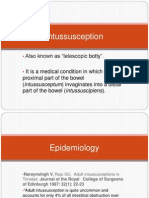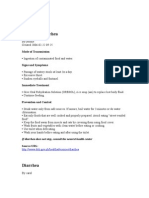Lower GI Bleeding
Lower GI Bleeding
Uploaded by
Taleb AliCopyright:
Available Formats
Lower GI Bleeding
Lower GI Bleeding
Uploaded by
Taleb AliCopyright
Available Formats
Share this document
Did you find this document useful?
Is this content inappropriate?
Copyright:
Available Formats
Lower GI Bleeding
Lower GI Bleeding
Uploaded by
Taleb AliCopyright:
Available Formats
LOWER GASTROINTESTINAL BLEEDING
Lower GI bleeding may be: Frank - blood is visible - massive bleeds rare (will show hypovolaemic shock) and often stop spontaneously. - small bleeds more common at all age groups Occult blood or its breakdown products in stool not macroscopically visible. - may manifest early as altered colour of faeces (use faecal occult blood (FOB) test to confirm presence of blood in the stool samplebut a negative result does not exclude GI pathology as bleeds can often be intermittent ) - may present later with symptoms of iron deficiency anaemia
Aetiology Source of bleeding may be in the small bowel, large bowel or anal canal. Cause of bleeding may be underlying GI pathology, trauma anywhere along the GI tract or iatrogenic (e.g. radiation proctitis; post-polypectomy bleeding) Massive and rapid upper GI bleeds may also occasionally manifest as bleeding per rectum. Pathological causes of lower GI bleeding: Small intestines & proximal colon: Meckels Diverticulum (commonest cause in teenagers) Intussusception (usually in young children) Enteritis Angiodysplasia* (usually in elderly) Caecal carcinoma Colon: Carcinoma * Polyps* Diverticular disease* (usually in elderly) Colitis - ulcerative colitis - Crohns disease - ischaemic colitis - infective colitis Rectum: Rectal carcinoma Proctitis Solitary rectal ulcer Anus: Haemorrhoids* Anal fissure (common cause in children) Anal warts Anal carcinoma
* common causes of lower GI bleeds Perianal Crohns disease Management For major GI bleeds it is necessary to resuscitate and stabilise (IV fluids and crossmatch blood for transfusion) patient before assessing the cause of bleeding. An oesophagogastroduodenoscopy (OGD) will also often be done to exclude upper GI causes.
The aim of management is to locate the site of bleeding, arrest bleeding (if it has not already stopped spontaneously) and treat the cause. History: Important information about the bleeding: Volume and frequency of bleeding Is defecation painful? Painful defecation with bleeding usually due to anal fissure Relationship of bleeding to defecation: before during after: bleeding most likely from an anal condition unrelated: blood from a rapidly bleeding source collecting in the rectum, giving rise to the desire to defecate. If bleeding is during defecation, is the blood mixed into the faeces or just coating the surface? If the blood is mixed in with the faeces, source of bleeding likely to be proximal to the sigmoid colon (as stool softness and transit time needs to be sufficient to allow mixing). If coating surface of faeces, source of bleeding usually from the lower sigmoid colon, rectum or anal canal. Associated abdominal pain? If present bleeding likely to have an inflammatory cause Colour of blood? bright red blood likely to have its source in the lower rectum or anal canal. dark red blood likely to have its source in a more proximal region of the bowel. Investigations: Bloods: FBC (may have low Hb; raised WCC if inflammatory cause) U&Es (baseline; upper GI bleeds leads to elevated urea levels) Inflammatory markers e.g. CRP (if inflammatory cause of bleeding) LFTs (abnormality may indicate liver pathology e.g. 2o metastases) Clotting screen (bleeding diatheses; liver pathology) Tumour Markers e.g. CEA Rectal examination and proctoscopy (may reveal low-lying pathology) Rigid and flexible sigmoidoscopy (may reveal left sided colonic pathology) Colonoscopy (may reveal pathology anywhere along entire colon) Barium Enema (usually used if colonoscopy would not be tolerated or high risk of perforation present)
Angiography (if bleeding persists in severe acute haemorrhage and urgent need to find the cause.)
Treatment: Minor GI bleeds: Varies depending on the cause of the bleed. Involves management of the underlying condition. If chronic bleed has led to anaemia, then oral iron may be given. Major GI bleeds: Most lower GI bleeds will terminate spontaneously; therefore once the patient is stabilised treatment will centre on managing the primary cause of the bleed as in minor bleeds. Surgical intervention rare but if the bleeding persists and source is known resection of the involved bowel may be required. Bleeding from vascular malformations can be stopped by embolizing the vessel radiologically. If bleeding persists but source is unclear, a laparotomy and intraoperative colonoscopy may be needed to find the site. If location still elusive then a total colectomy may be needed.
You might also like
- 1 - Fluid and Electrolytes (Schwartz Based)Document52 pages1 - Fluid and Electrolytes (Schwartz Based)Alexandra RebosuraNo ratings yet
- Páginas Desdepharmacotherapy Casebook 10th Ed.Document61 pagesPáginas Desdepharmacotherapy Casebook 10th Ed.Glo VsNo ratings yet
- CHOLEDOCHOLITHIASISDocument38 pagesCHOLEDOCHOLITHIASISPrecious Cofreros100% (3)
- Acute PancreatitisDocument11 pagesAcute PancreatitisChoirina QomariahNo ratings yet
- Pathophysiology of NephrosclerosisDocument2 pagesPathophysiology of NephrosclerosisJessica Damasen Caballero50% (2)
- Differential Diagnosis of JaundiceDocument4 pagesDifferential Diagnosis of JaundiceVirag PatilNo ratings yet
- Ugib &lgibDocument41 pagesUgib &lgibDawex IsraelNo ratings yet
- CholangitisDocument4 pagesCholangitisNarianne Mae Solis Bedoy100% (1)
- Intestinal ObstructionDocument27 pagesIntestinal ObstructionAna AvilaNo ratings yet
- Nu'man AS DaudDocument23 pagesNu'man AS DaudHidayat BazeherNo ratings yet
- Portal HypertensionDocument4 pagesPortal HypertensiondrstalamNo ratings yet
- Colloids and CrystalooidsDocument42 pagesColloids and Crystalooidsلؤي زعيترNo ratings yet
- Lower GI Bleeding SlideDocument29 pagesLower GI Bleeding Slideraed faisalNo ratings yet
- Anemia Secondary GI BleedingDocument6 pagesAnemia Secondary GI BleedingfentisellikurniaNo ratings yet
- CholecystitisDocument27 pagesCholecystitisKadek Ariarta MahartamaNo ratings yet
- Hernia: Presented by MR - Jeyaprakash M.SC (N) Iind Year V.M.A.C.O.N, SalemDocument27 pagesHernia: Presented by MR - Jeyaprakash M.SC (N) Iind Year V.M.A.C.O.N, SalemSasi KumarNo ratings yet
- Portal HypertensionDocument60 pagesPortal HypertensionParul VarshneyNo ratings yet
- Cholangitis and Cholecystitis (DR - Dr. Hery Djagat Purnomo, SpPD-KGEH)Document47 pagesCholangitis and Cholecystitis (DR - Dr. Hery Djagat Purnomo, SpPD-KGEH)Aditya SahidNo ratings yet
- Liver AbscessDocument6 pagesLiver AbscessKenneth SunicoNo ratings yet
- Anal Canal: Fissure in Ano HaemorrhoidsDocument37 pagesAnal Canal: Fissure in Ano Haemorrhoidsyash shrivastavaNo ratings yet
- Gastric AnalysisDocument1 pageGastric AnalysisJose Paul RaderNo ratings yet
- Approach To Jaundice (1) .PPT ALAWAJIDocument28 pagesApproach To Jaundice (1) .PPT ALAWAJIayuNo ratings yet
- HERNIORRHAPHYDocument2 pagesHERNIORRHAPHYSheldon Deypalubos Jr.No ratings yet
- Congestive Cardiac FailureDocument38 pagesCongestive Cardiac FailureSalman KhanNo ratings yet
- Cholelithiasis: Group MembersDocument12 pagesCholelithiasis: Group MembersShiela Gutierrez0% (1)
- Biochemistry of Jaundice 03Document52 pagesBiochemistry of Jaundice 03Cathleen May Dela Cruz50% (2)
- PEPTIC ULCER DISEASE 2018 EdittedDocument43 pagesPEPTIC ULCER DISEASE 2018 EdittedJumbe MohamedNo ratings yet
- Case of Obstructive JaundiceDocument23 pagesCase of Obstructive JaundiceAjay Agrawal100% (1)
- Ashley Esdaile MSIII Byron Baptist MSIII Mike Pothen MS IIIDocument77 pagesAshley Esdaile MSIII Byron Baptist MSIII Mike Pothen MS IIISutapa PawarNo ratings yet
- Acute Cholecystitis: Pableo, Rachel MDocument47 pagesAcute Cholecystitis: Pableo, Rachel MLd Rachel PableoNo ratings yet
- PallorDocument27 pagesPallorAwatef AbushhiwaNo ratings yet
- Peptic Ulcer PresentationDocument46 pagesPeptic Ulcer Presentationmaryam ijazNo ratings yet
- GI Bleeding - NursesDocument71 pagesGI Bleeding - Nursesapi-3760283100% (6)
- Peptic Ulcer DiseaseDocument36 pagesPeptic Ulcer DiseaseRamanujam Sekar100% (1)
- Ascites: Pathogenesis and Clinical ApproachDocument34 pagesAscites: Pathogenesis and Clinical ApproachPooja ShashidharanNo ratings yet
- Liver AbscessDocument15 pagesLiver AbscessAli Aborges Jr.No ratings yet
- Mitral StenosisDocument2 pagesMitral StenosisKing Bal94No ratings yet
- Management of Lower GI BleedDocument48 pagesManagement of Lower GI BleedMegat Mohd Azman Adzmi100% (1)
- Obstructive JaundiceDocument54 pagesObstructive JaundiceJenine Ezra M. Conol50% (2)
- Carcinoma StomachDocument43 pagesCarcinoma StomachRukman Mecca100% (1)
- Intestinal Obstruction 4Document25 pagesIntestinal Obstruction 4Muvenn KannanNo ratings yet
- CholelithiasisDocument37 pagesCholelithiasisbaby padzNo ratings yet
- Acid-Base - Ppt-How To ReadDocument22 pagesAcid-Base - Ppt-How To ReadnursaidahNo ratings yet
- Peptic Ulcer DiseaseDocument20 pagesPeptic Ulcer DiseaseALNAKINo ratings yet
- Pleural EffusionDocument51 pagesPleural EffusionMinhajul IslamNo ratings yet
- CholelithiasisDocument5 pagesCholelithiasisrgflores1979100% (2)
- Peptic Ulcer DiseaseDocument75 pagesPeptic Ulcer DiseaseSarah Gaile Tio Inac100% (4)
- Hemorrhagic ShockDocument14 pagesHemorrhagic Shockmutiara rizkiNo ratings yet
- Urolithiasis SeminarDocument50 pagesUrolithiasis SeminarSiddharth GuptaNo ratings yet
- IntussusceptionDocument14 pagesIntussusceptionAmit RamrattanNo ratings yet
- Gallbladder EmpyemaDocument17 pagesGallbladder EmpyemaYayut 18No ratings yet
- Upper Gastrointestinal Bleeding (Ugib) : First Shift: August 13, 2018Document10 pagesUpper Gastrointestinal Bleeding (Ugib) : First Shift: August 13, 2018Angelo Dela Cruz VillaromanNo ratings yet
- DiarrheaDocument4 pagesDiarrheapiskal88No ratings yet
- GlomerulonephritisDocument58 pagesGlomerulonephritisJosa Anggi Pratama0% (1)
- Pleural EffusionDocument3 pagesPleural EffusionRafahiah HaronNo ratings yet
- Intestinal ObstructionDocument46 pagesIntestinal ObstructionvenkatNo ratings yet
- Pancreatitis: Dr. Ahmad Aqel RN, PHD The University of Jordan 2015Document27 pagesPancreatitis: Dr. Ahmad Aqel RN, PHD The University of Jordan 2015Anonymous 5HzElnmNo ratings yet
- Acute PancreatitisDocument35 pagesAcute PancreatitisJerson Ingno100% (5)
- Treatment of Peptic UlcerDocument27 pagesTreatment of Peptic Ulcerapi-3761895100% (3)
- Ventricular Septal Defect, A Simple Guide To The Condition, Treatment And Related ConditionsFrom EverandVentricular Septal Defect, A Simple Guide To The Condition, Treatment And Related ConditionsNo ratings yet
- Community Acquired Pneumonia, A Simple Guide To The Condition, Diagnosis, Treatment And Related ConditionsFrom EverandCommunity Acquired Pneumonia, A Simple Guide To The Condition, Diagnosis, Treatment And Related ConditionsNo ratings yet
- Blurring of Vision Ii: Retinal Vascular Disorders: Dr. Jose BondocDocument15 pagesBlurring of Vision Ii: Retinal Vascular Disorders: Dr. Jose BondocRea Dominique CabanillaNo ratings yet
- Goodpasture's Syndrome, Hashimoto's Thyroiditis, Graves's Disease & Type I DiabetesDocument2 pagesGoodpasture's Syndrome, Hashimoto's Thyroiditis, Graves's Disease & Type I DiabetesZara MohammedNo ratings yet
- MnemonicsDocument1 pageMnemonicscoaneu6No ratings yet
- Devesh Chandra Digital HerbariumDocument21 pagesDevesh Chandra Digital HerbariumAnup JiNo ratings yet
- Laboratory Report: Immunology Thyroid Function TestDocument1 pageLaboratory Report: Immunology Thyroid Function Testudesh LuitelNo ratings yet
- Autoimmune Hepatitis: Dr. Andi Nadya Febriama DR - DR Am - Lutfi Parewangi, SPPD KgehDocument25 pagesAutoimmune Hepatitis: Dr. Andi Nadya Febriama DR - DR Am - Lutfi Parewangi, SPPD KgehDeddy TrimarwantoNo ratings yet
- MPhil Thesis Defence - Schedule of Presentation - October 2021Document1 pageMPhil Thesis Defence - Schedule of Presentation - October 2021Saheed AbdulkarimNo ratings yet
- RSMPD Abstract E-BookDocument185 pagesRSMPD Abstract E-BookjesslinaNo ratings yet
- National Voluntary Blood Services Program (NVBSP) : MissionDocument4 pagesNational Voluntary Blood Services Program (NVBSP) : Missionveronica gamoso100% (1)
- Polycystic Ovary/Ovarian Syndrome (PCOS) : Underrecognized, Underdiagnosed, and UnderstudiedDocument16 pagesPolycystic Ovary/Ovarian Syndrome (PCOS) : Underrecognized, Underdiagnosed, and UnderstudiedcaneNo ratings yet
- Diagnosticul Diferenţial Al Adenopatiei Metastatice CervicaleDocument5 pagesDiagnosticul Diferenţial Al Adenopatiei Metastatice CervicaleAlina AlexandraNo ratings yet
- Attempts: Over Are AnDocument2 pagesAttempts: Over Are AnSayed AbozeidNo ratings yet
- Updated Workplace Coronavirus Prevention PlanDocument6 pagesUpdated Workplace Coronavirus Prevention Planvictor100% (4)
- Instructions For Completing The Cause of Death Section On Death Certificate PDFDocument2 pagesInstructions For Completing The Cause of Death Section On Death Certificate PDFpilcheritoNo ratings yet
- School RefusalDocument46 pagesSchool RefusalF. HammoudNo ratings yet
- GI Problems in Early Life EditDocument59 pagesGI Problems in Early Life EditNyomanGinaHennyKristiantiNo ratings yet
- Drug Study ParacetamolDocument2 pagesDrug Study ParacetamolAce FabrigasNo ratings yet
- Cir 0000000000000628Document101 pagesCir 0000000000000628Diana AngelesNo ratings yet
- Practicalreviewof Ovariansexcord-Stromal Tumors: Krisztina Z. Hanley,, Marina B. MosunjacDocument34 pagesPracticalreviewof Ovariansexcord-Stromal Tumors: Krisztina Z. Hanley,, Marina B. MosunjacJulia LugonNo ratings yet
- ECG IMM 2020.docx.2Document25 pagesECG IMM 2020.docx.2Abdul QuyyumNo ratings yet
- Eating DisordersDocument3 pagesEating Disordersarundhatig125No ratings yet
- Olimpiadajudeteanaclasa 10Document1 pageOlimpiadajudeteanaclasa 10Ádámkó RékaNo ratings yet
- Spinal Orthoses: Type Examples Motion Restriction Indications NotesDocument2 pagesSpinal Orthoses: Type Examples Motion Restriction Indications NotesBD BesorioNo ratings yet
- Soal Ujian Ilmu Bedah MulutDocument7 pagesSoal Ujian Ilmu Bedah MulutM Yusuf SyaifullahNo ratings yet
- Atherosclerosis: Yang Haibo MD Department of Cardiology, 1 Affiliated Hospital of ZzuDocument22 pagesAtherosclerosis: Yang Haibo MD Department of Cardiology, 1 Affiliated Hospital of Zzuapi-19916399No ratings yet
- Bunion: Strengthening Foot Muscles To Reduce Pain and Improve MobilityDocument1 pageBunion: Strengthening Foot Muscles To Reduce Pain and Improve Mobilitymucki_provokatorNo ratings yet
- Clotting Concept Analysis Diagram and ExplanationDocument2 pagesClotting Concept Analysis Diagram and ExplanationJulius Haynes100% (1)
- Pictorial Essay: Sonographic Evaluation of Cervical Lymph NodesDocument9 pagesPictorial Essay: Sonographic Evaluation of Cervical Lymph NodesAhmad SastiantoNo ratings yet
- HOA-Multiple Sclerosis FINALDocument4 pagesHOA-Multiple Sclerosis FINALNewsChannel 9No ratings yet

























































































